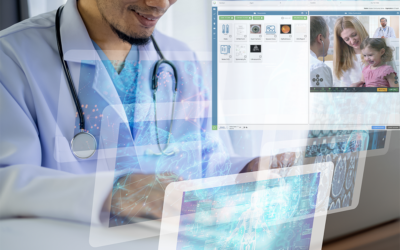This article was originally published in January 2021 but was updated in June 2022.
How school-based telemedicine can help the healthcare system navigate the pandemic
The COVID-19 pandemic has turned the healthcare system upside down, becoming one of the largest global health crises we may face in our lifetime. It has challenged not only the opportunity for patients in need to receive care, but it’s had a negative impact on the way major hospitals and other centers of care can provide assistance and reach those testing positive for the virus and others dealing with other critical health situations. This impacts all ages, from elderly populations down to school-aged children.
Telemedicine can be a significant approach to assisting those in need who can’t receive proper care in hospitals at the moment; schools, specifically, can benefit from implementing a telehealth solution that can keep kids in school and treat them in place.
Let’s take a closer look at the challenges COVID-19 poses to our current healthcare system and some of the benefits that come with school-based telemedicine as the world stands today:
Current challenges of the healthcare system
One of the most significant challenges faced by our healthcare system during the pandemic involves financial pressure. According to a report by the American Hospital Association, an estimated $202.6 billion accounted for losses in the hospitals and health systems across the country between March and June 2020, totaling an average loss of $50.7 billion per month. The factors that impacted this lost revenue included COVID-19 hospitalization costs, cancelation of services unrelated to the virus, additional costs associated with personal protective equipment and money provided to hospital workers as additional support during these trying times.
As mentioned, fewer patients are getting treated for their chronic diseases and other non-COVID-related symptoms. This means care providers have a backlog of patients that need help maintaining their conditions, which not only affects the hospitals, but more severely the long-term health of those patients in need.
How school-based telemedicine can assist
School-based telemedicine is considered one solution for facing these current health care challenges head-on. Due to the robust reimbursement for telemedicine during the pandemic, integrating telehealth into a school setting is a billable service. This also provides increased access points for chronically ill patients who need to manage their conditions on a regular basis.
Tiffany Griffis, the chief nursing officer at Eastern Oklahoma Medical Center, described how useful telemedicine can be in school settings.
“We can listen to the heart and the lungs, look in the eyes and the ears and the nose, and really do an assessment,” Griffis shared with local station KFSM 5NEWS. “[It’s] kind of an EMT type of assessment of the patient and just a general patient appearance type thing.”
Doctors and care providers are focusing all their efforts on COVID-related patients.
Another major benefit of telehealth in schools is its ability to treat children in place, providing quality care without the need to leave the school. Poteau and Howe school districts in Le Flore County in Oklahoma, for example, are currently working with Eastern Oklahoma Medical Center to establish and utilize a telehealth presence in their schools.
According to the county’s local news, this is the first telehealth program the state of Oklahoma has seen to date.
“It’s an opportunity to have a clinical person evaluate them while they’re here without having to leave school and without their parents having to leave their jobs and come and take them to the doctor,” Dr. Don Sjoberg, superintendent of Poteau Public Schools shared with the news source.

Overall benefits of school-based telemedicine
The overall benefits of integrating telehealth into schools are especially impactful for students and families.
First, there is the obvious benefit of faster access to high-quality healthcare. With school-based telehealth in play, children will get a quick response from trained medical professionals, whether they are navigating a minor injury or a chronic condition. A shorter time from injury to diagnosis will get children back to learning and playing.
School operations as a whole can benefit from the integration of telemedicine, as well. If a school or district does not have a full-time nurse or health staff available, school-based telemedicine can fill an important gap. Faster access to crucial healthcare means fewer students will need to leave school early or leave the classroom to visit the emergency room for treatable issues. Telehealth in public schools can help keep the school day on track for all.
Lastly, school-based telehealth can be a major benefit for working parents. When a student gets ill or injured at school, quickly leaving work poses challenges for parents, and in these cases, telehealth provides quick answers. And for those families who lack access to quality healthcare, school-based telehealth offers a solution for children to be seen by health professionals.
As a global leader in telemedicine solutions, AMD Global Telemedicine strives to provide a convenient, quality care experience to vulnerable communities, especially during these trying times. Learn more about how we’ve enabled rural communities to develop and implement a school-based telemedicine program, and how we’ll continue to implement telemedicine solutions so hospitals and community care facilities can properly help those in need during the unpredictable and ever-changing healthcare landscape.
Download our solutions brochure for school-based telemedicine, or reach out to us directly today to learn more.






